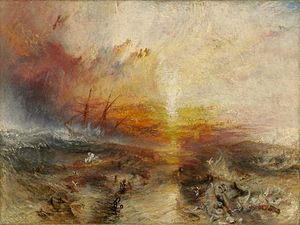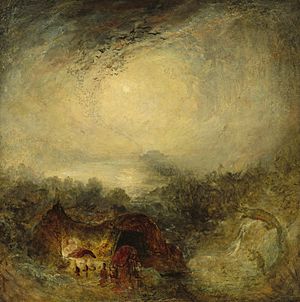The Slave Ship facts for kids
Quick facts for kids The Slave Ship |
|
|---|---|
| Slavers Throwing overboard the Dead and Dying—Typhon coming on | |
 |
|
| Artist | J. M. W. Turner |
| Year | 1840 |
| Medium | Oil on canvas |
| Dimensions | 91 cm × 123 cm (36 in × 48 in) |
| Location | Museum of Fine Arts, Boston |
The Slave Ship is a famous painting by the British artist J. M. W. Turner. It was first shown in 1840 at The Royal Academy of Arts. The painting is also known by its longer title: Slavers Throwing overboard the Dead and Dying—Typhon coming on.
This artwork is painted with oil on canvas and measures about 91 cm by 123 cm. You can see it today at the Museum of Fine Arts, Boston. It's a great example of a Romantic maritime painting, which means it shows a dramatic scene at sea.
In the painting, Turner shows a ship in the distance. It sails through a rough, stormy ocean. Behind the ship, you can see human figures floating in the water. Turner was likely inspired to paint this after reading about a terrible event involving a slave ship called the Zong. This event happened in 1781.
The painting was first shown in 1840. This was a time when many people around the world were fighting to end slavery. Because of this, the painting became an important symbol for the abolitionist movement.
Contents
What Inspired the Painting?
The Zong Incident
In 1781, a sad event happened on a slave ship called the Zong. The ship was sailing to Jamaica. The captain ordered 132 enslaved people to be thrown into the sea. This happened because the ship was running out of drinking water. The captain wanted to claim insurance money for them. Insurance usually did not cover people who died from natural causes.
This incident led to a court case. The trial became very public and helped many people support the idea of ending slavery. Even though the trial didn't fully solve the issue, it was a key moment. It pushed Britain closer to ending the slave trade. This event later inspired Turner to create The Slave Ship.
Ending Slavery in Britain
The first organized movement to end slavery in Britain started in 1727. However, the slave trade in the British Empire was not officially stopped until 1807. Slavery itself was finally abolished in 1833. After this, ending slavery everywhere became a big political goal for Britain.
People wanted to end slavery mainly because it was inhumane. But there were also economic reasons. Countries wanted to stop this trade in other competing nations.
About J. M. W. Turner
J. M. W. Turner was a famous landscape painter from the 1800s. He was born in London in 1775. People admired him for his new and unique painting style. He had a lot of art training. He started studying at the Royal Academy when he was just fourteen. He also learned a lot about drawing landscapes and using watercolors. This helped him develop his special way of using colors.
Turner believed in liberal ideas and cared about current events. He knew a lot about the anti-slavery groups of his time. These groups included the Society for the Mitigation and Gradual Abolition of Slavery Throughout the British Dominions and the British and Foreign Anti-Slavery Society. Their work shaped his strong belief that slavery should end.
As an abolitionist, Turner wanted to help stop slavery in other parts of the world, like the United States. In 1828, he showed his support for the anti-slavery movement. He dedicated an engraving of his painting The Deluge to a well-known abolitionist named John Joshua Proby.
Twelve years later, Turner learned more about the Zong incident. He also heard about the Amistad rebellion in the United States, which was big news. These terrible events inspired him to paint The Slave Ship.
Showing the Painting to the Public
In 1840, two important international meetings about ending slavery took place in London. Turner's painting, The Slave Ship, was shown at the Royal Academy of Arts at the same time. This public display of such a horrific event reminded people of Britain's past. It also aimed to make viewers feel strongly about the cruel slave trade still happening elsewhere.
Because of when it was shown, the painting was likely seen as a political message. It was a call for people to take action against slavery. When Turner showed the painting, he included a part from his own poem, Fallacies of Hope:
-
- "Aloft all hands, strike the top-masts and belay;
- Yon angry setting sun and fierce-edged clouds
- Declare the Typhon's coming.
- Before it sweeps your decks, throw overboard
- The dead and dying – ne'er heed their chains
- Hope, Hope, fallacious Hope!
- Where is thy market now?"
This poem helps explain the painting's sad and urgent message.
What Does the Painting Show?
The Scene and Its Details
At first glance, the painting shows a huge, deep-red sunset over a stormy sea. This red sky suggests a powerful typhoon is coming. A dramatic storm cloud moves in from the left, its rich colors spreading across the sky.
If you look closer, you can see a ship sailing far away. This ship looks like the fast vessels used by slave traders to escape navy ships. Its masts are red, matching the blood-red sky and the sickly copper color of the water. This makes everything blend together. The ship's sails are tied up, showing it is getting ready for the typhoon.
In the front right corner of the painting, a dark-skinned leg sticks out of the water. An iron chain is wrapped around its ankle. A chaotic group of seagulls and fish surrounds the leg. They look like they are eating the person. One fish is shown swimming towards the chaos with its mouth wide open. Small red spots near the fish's head suggest blood, making the scene even more violent.
On the left, smaller dark limbs appear from the stormy sea. Loose chains float around them. This shows that many other enslaved people were thrown off the ship and left to drown. You can also see fish tails in the water around the drowning people. This adds to the feeling of chaos and struggle.
Turner's Painting Style
Turner loved to use color in his artworks, and this painting is a great example. The main focus is on how different colors mix and interact. There are not many clear brush strokes. Objects, colors, and figures often blend together.
Things are defined by their colors, not by sharp lines. Some parts, like the human bodies in the water and the storm, don't have clear edges. They are only defined by how their colors contrast with the colors around them. The most noticeable colors are the red of the sunset, which spreads into the water and onto the ship. The bodies and hands of the enslaved people are a dark reddish-brown.
This is typical of Turner's style. He often made colors stronger and left out small details. This made his paintings feel more fluid and dramatic. He wanted viewers to feel strong emotions when they saw his art. At the peak of his career, Turner simplified landscapes. He made details blurry and used colors to create a powerful feeling.
Lasting Impact
In 2006, this painting was featured in a BBC TV series called Simon Schama's Power of Art. It was the focus of one of the episodes.
See also
- List of paintings by J. M. W. Turner


